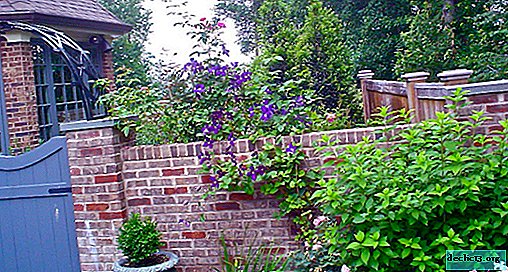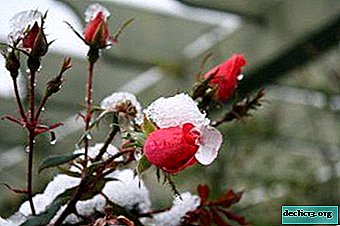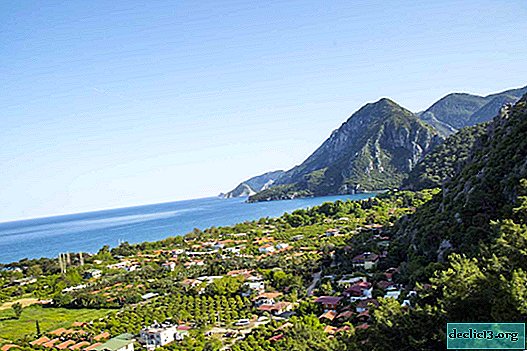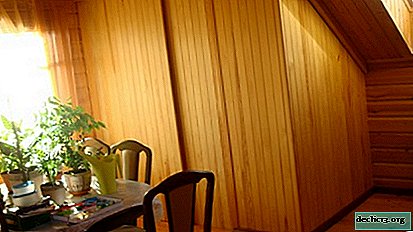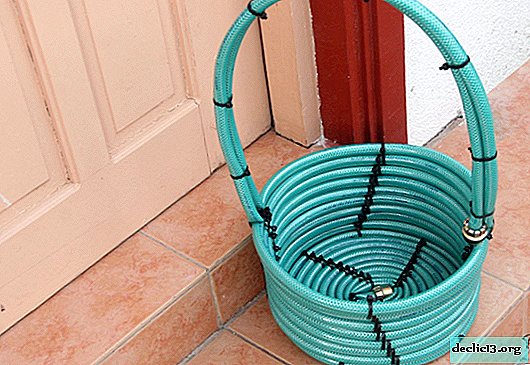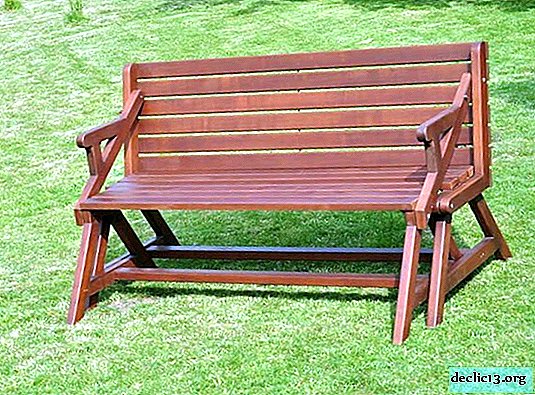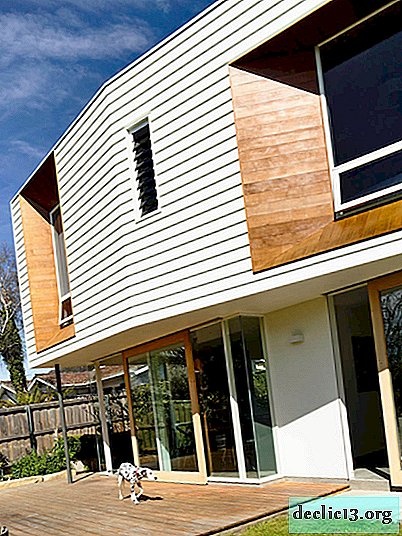Marvelous plant with bright spikes - echinocactus Gruzoni red
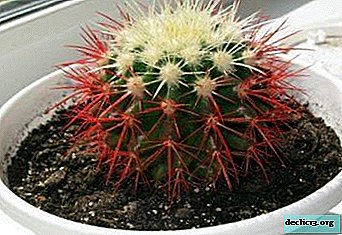
An unusual spherical cactus with bright red spines and a light crown is the echinocactus of Gruzoni red. This original long-liver is completely unpretentious, grows well even in apartment conditions.
In this article we will talk about how to care for this species at home and in the open ground, what are its distinguishing features and how to breed it properly. We also describe the pests and diseases that threaten this plant.
Botanical Description
Echinocactus Gruzoni red - this is not a bred hybrid variety, it is colored with food colors Echinocactus Gruzoni. On sale there are purple and pink varieties. Echinocactus Gruzoni red (Echinocactus grusonii) - the succulent species of the genus Echinocactus belongs to the large cactus family.
 The plant has a rounded, barrel-shaped stem of dark green color. The stem height under natural conditions can reach with age up to 100 - 130 cm. In diameter, this variety grows to 80 - 90 cm. At home, this species grows no more than 40 cm in diameter.
The plant has a rounded, barrel-shaped stem of dark green color. The stem height under natural conditions can reach with age up to 100 - 130 cm. In diameter, this variety grows to 80 - 90 cm. At home, this species grows no more than 40 cm in diameter.
As you grow older, the trunk stretches up a bit. There are more than 30 ribs. A large number of areoles are formed on the ribs, spines yellow with an amber hue. Spines are long, dense, up to 5 cm in length. At the top, the thorns are lighter, whitish, grow densely. Due to its rounded shape and natural color of thorns, the flower was called the golden ball, the golden barrel.
Echinocactus Gruzoni was discovered at the end of the 19th century. The natural habitat is central Mexico. The view is named after Herman Gruzon, a scientist, inventor, industrialist. He presented his huge collection of cacti to Mr. Magdeburg.
Distinctive features
The tinted echinocactus of Gruzoni red grows quickly, the thorns change color to their natural, amber - honey hue. The crown becomes white over time, the spines at the base also grow back. The variety is distinguished by endurance and longevity. Scientists claim that the plant can live up to 500 years. Exotics that have reached 100 years of age grow in greenhouses and botanical gardens!
How to care for this species at home?
Temperature
In spring and summer, the most optimal temperature regime is -20 - 25 ° C. An increase in temperature is undesirable, the flower overheats, begins to fade, the growth and development of the flower slows down. In autumn, the air temperature should gradually decrease to 10 - 15 ° C.
Watering
Watering is moderate, like all succulents, echinocactus Gruzoni red does not tolerate dampness and excessive moisture. In spring and summer, it should be watered 1 time in 10 -12 days. In extreme heat, it is recommended to lightly spray the stem to reduce the temperature. Spraying cleanses the dust and refreshes the flower. In the fall, watering is reduced.
Important! Between watering, the soil should dry well. It is better to water through a pan or by immersion. Water after irrigation must be immediately drained from the pan; wetting of the roots is unacceptable.Shine
The variety is not afraid of direct sunlight. Pots are best installed on the south, southeast side of the house. After wintering, the plant is gradually accustomed to direct sunlight. From a lack of light, the stem is deformed, wrinkled, grows one-sidedly, can reset the thorns. Turn the pots clockwise periodically so that the light comes in evenly.
Priming
 The soil should be light, loose, enriched with minerals, slightly acidic. Small stones, gravel, crumbs of red brick are used as drainage.
The soil should be light, loose, enriched with minerals, slightly acidic. Small stones, gravel, crumbs of red brick are used as drainage.
The composition of the soil mixture:
- Sheet land - 1 h.
- Sod land - 2 hours
- Coarse river sand - 1 hour.
- Peat - 1 hour
- Drainage.
To prevent fungal diseases, it is recommended to add crushed charcoal to the soil.
Pruning
Special form-forming pruning is not needed for this species. In case of stem disease or root decay, the plant needs urgent help:
- The flower is carefully removed from the pot.
- Rotten roots are cut off completely.
- The trunk is cut from all sides, wedge-shaped, around the entire circumference.
- Slices are powdered with powdered activated charcoal or charcoal.
- The turned barrel is installed vertically in a dry transparent glass.
- Lighting is bright, watering stops.
New roots appear within a month.
Top dressing
Fertilize the flower begin after wintering. Top dressing continues until the end of summer. It is necessary to use special liquid fertilizers for cacti. The composition of fertilizers must necessarily include trace elements - chelates. Nitrogen fertilizers are applied only at the very beginning of spring.
To stimulate flowering, fertilize with potassium - phosphorus fertilizers ("Gilea for cacti and succulents"). For fertilizing the root system, concentrated fertilizers with magnesium and other trace elements are used. Organic top dressing is contraindicated. In the fall, top dressing is reduced.
Pot
The size of the pot in diameter should be 1 -1, 5 cm larger than the stem itself. The pot or container should not be too deep - the substrate will retain excess moisture. It is better to use ceramic containers, they do not overheat in the bright sun, they pass air well. At the bottom of the pot, holes are made for drainage of water.
Transfer
 A plant needs a transplant every 3 years, even if the flower has not outgrown the size of the container. When transplanting, the soil changes completely.
A plant needs a transplant every 3 years, even if the flower has not outgrown the size of the container. When transplanting, the soil changes completely.
Due to the dense spines, difficulties arise with the transplant procedure. It is necessary to use tight gloves or a special wire loop - a grip. The loop is carefully placed between the thorns, so as not to break them. Before planting, soil should be steamed or calcined in the oven for disinfection.
A transplant is recommended in early spring. Transplant Procedure:
- Using a loop, a flower is carefully removed from the pot.
- Dry and rotten root processes are cut out.
- Places of cuts are processed by crushed coal.
- 2 days, it is necessary to withstand the flower for the healing of cropped roots.
- The plant is transferred, the roots are deepened.
- Watering - through the pan 4 days after transplanting.
In order for the transplanted echinocactus to grow directly, without distortion, it is important to place it evenly in a new pot.
Wintering
Winter temperature of the flower is 9 - 11 ° C. Additional humidification is not required, watering is stopped.
The lower the temperature, the less moisture the plant requires. Brown spots appear on the stem from hypothermia, there is a risk of infection with a fungal infection.
To avoid freezing of the roots, the pots are installed on wooden stands. It is not required to feed the plant in winter. The lighting is bright. It is necessary to illuminate plants with special lamps for 2 to 3 hours a day.
More information on general care for echinocactus can be found here.
Outdoor Care
In temperate latitudes, echinocactus Gruzoni red does not grow in open ground. In the summer, the pots are carried out to the balcony or terrace under direct sunlight. Fresh air has a good effect on flower growth. In the heat, you can spray the stems with warm, settled water from a fine spray. It is better to spray in the early morning, before sunrise.
Breeding
Seeds
Experienced growers can grow this species through sowing. The process is painstaking and lengthy. Sowing is carried out in April. Seeds have good germination. Pre-soaked seeds for 2 to 3 hours in water at room temperature. The container is spacious, shallow with drainage holes.
The scheme of growing seedlings:
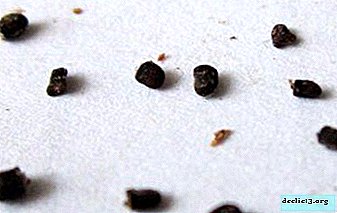 A drainage layer, 3-4 cm, is poured at the bottom of the pot.
A drainage layer, 3-4 cm, is poured at the bottom of the pot.- The sifted substrate is evenly poured.
- Seeds are distributed on the surface evenly, without deepening.
- Sowing is sprinkled with a thin layer of soil mixture.
- Sowing is covered with a film.
- The greenhouse is regularly ventilated.
- Shoots appear within a month.
- As the seedlings grow, they dive into separate containers.
- Watering carefully, the lighting is bright.
Kids
Children - processes of this variety appear extremely rarely.
Attention! The stem branches only in case of damage to the apex or flower disease.The scheme of separation of children:
- The processes having roots are cut off.
- Places trimmed sprinkled with charcoal.
- The shoot is dried for 2 days in partial shade.
- A process is placed in a small container with a drained substrate.
- The roots are deepened, sprinkled with soil.
- Watering after 3 days by immersion.
- Rooting takes place quickly, within 2-3 weeks.
How to propagate in open ground?
In open ground, the plant can only be propagated in a warm climate. Seeds are sown most often in greenhouses and special nurseries, where special conditions for maintaining seedlings are created.
Bloom
Flowering occurs in the summer. The flowers are gently yellow, medium in size, up to 6 cm in diameter. Flowers - bells bloom alternately, are located on the top of the stem. Petals are narrow, oblong.
What to do if it does not bloom?
Echinocactus Gruzoni red rarely blooms at home. Plants bloom only after 20 - 25 years.
To stimulate flowering, the wintering regime should be observed - cool content and bright lighting. In summer, it is imperative to take out the pots to fresh air.
Diseases and Pests
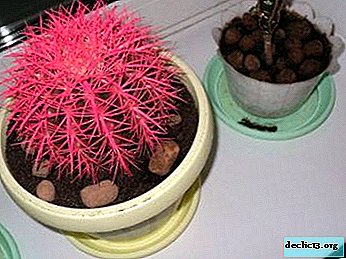 From overflow and cold air appears root rot. Urgent pruning, growing new roots, transplanting is required.
From overflow and cold air appears root rot. Urgent pruning, growing new roots, transplanting is required.- Late blight It is treated only in the early stages of the lesion. Damaged areas are cut off. The soil is changing, transplanting is needed.
- From mealybug Soap spraying will help. The soil is covered with a film.
- Shields destroyed by treating the shell of insects with vinegar or alcohol. Pests are cleaned manually.
- From a red spider mite, spraying with any insecticides will help.
5 similar plants
- Echinocactus horizontal - compact stalk, spines at a young age have a reddish tint.
- Huge echinocactus (wide-needle) grows over 100 cm in height. The flowers are yellow, funnel-shaped.
- Echinocactus flat-throated different straight, dense spines. The flowers are yellow, up to 4 - 5 cm in diameter.
- Echinocactus polycephalus. The thorns are yellowish, may have a reddish tint, up to 5 cm in length. The flowers are medium, yellow in color.
- Echinocactus texas - a low stem has a spherical shape. The top is covered with a white hair covering.
You can get acquainted with different types of echinocactus in this article, and here is general information about echinocactus.
Echinocactus Gruzoni red, even after colored spines grow, does not lose its attractiveness and decorativeness. It fits perfectly into any home interior, does not require special attention and care.

 A drainage layer, 3-4 cm, is poured at the bottom of the pot.
A drainage layer, 3-4 cm, is poured at the bottom of the pot. From overflow and cold air appears root rot. Urgent pruning, growing new roots, transplanting is required.
From overflow and cold air appears root rot. Urgent pruning, growing new roots, transplanting is required.

